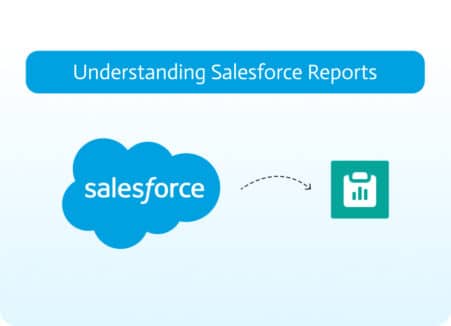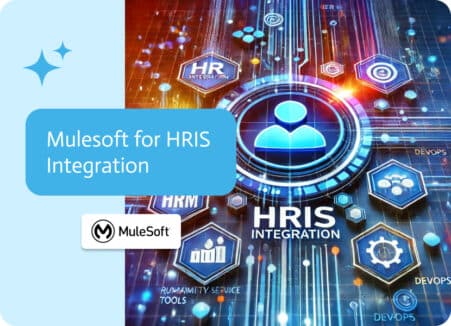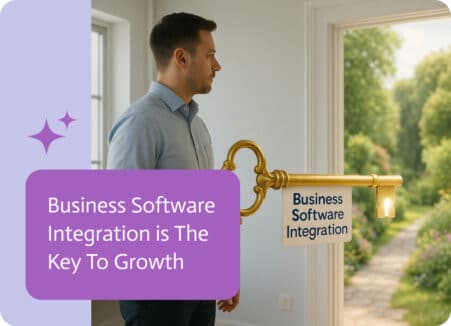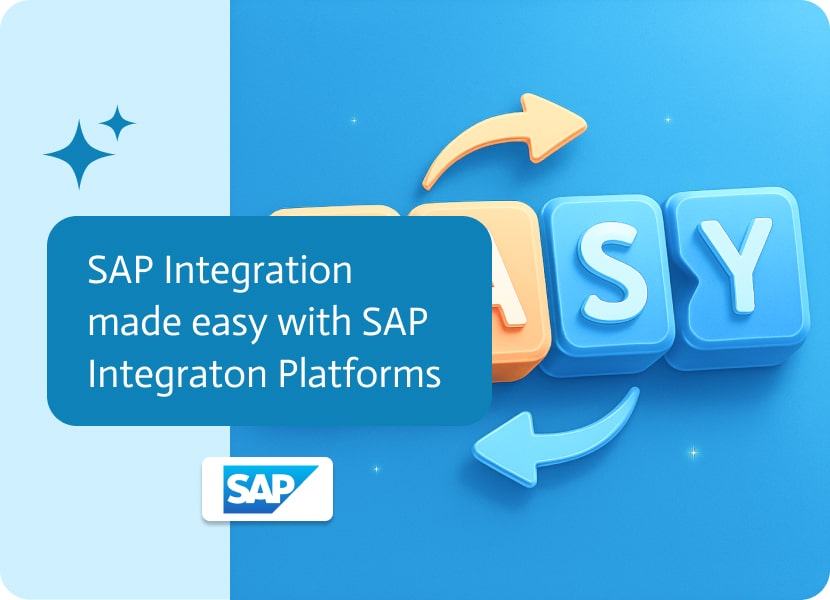
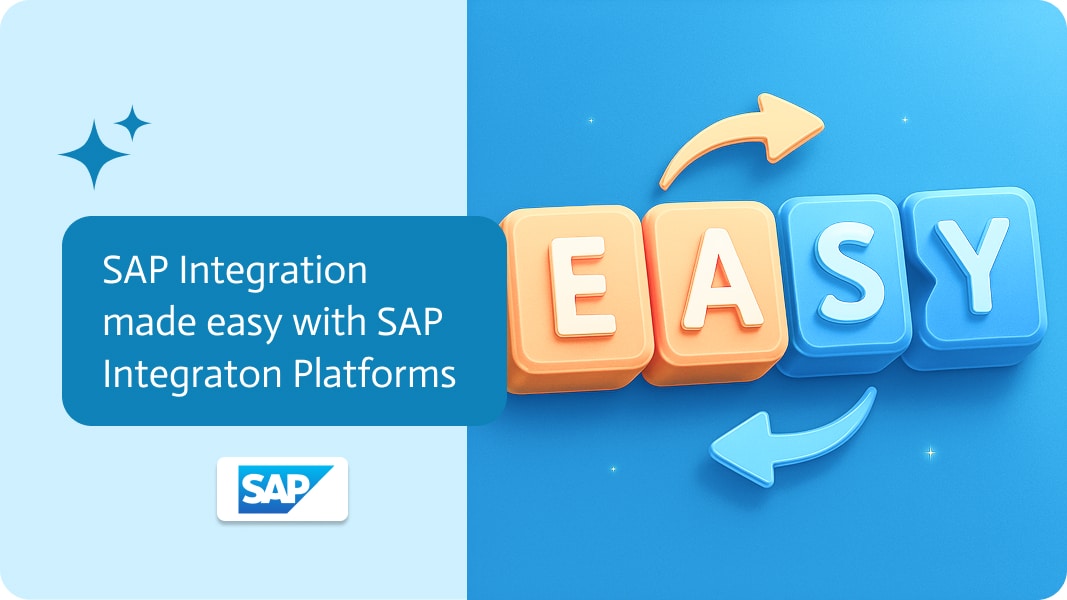
SAP Integration made easy with SAP Integraton Platforms
Integrating SAP systems with other enterprise applications has always been a crucial part of business operations. It’s not just about connecting systems; it’s about ensuring seamless data flow across your entire organization. Whether you’re managing supply chains, handling customer relationships, or overseeing financial processes, SAP integration is key to keeping everything running smoothly. But here’s the rub—traditional integration methods are often a headache. They demand significant coding skills and deep technical expertise, making them less than ideal for many organizations.
Luckily, there’s a new player in town—AI-first, no-code iPaaS platforms like Noca AI. These platforms are making SAP integration easier, more efficient, and accessible to everyone, not just your IT team. Today, let’s dive into how these AI-driven platforms are changing the game. We’ll also look at some real-world scenarios and discuss the pros and cons.
Why Traditional SAP Integration Can Be a Pain
If you’ve been in the trenches with SAP integration, you know it’s not always a walk in the park. Typically, you’re looking to connect SAP with other applications like CRMs, e-commerce platforms, or logistics systems. But this isn’t just plug-and-play. It’s a complex task, and here’s why:
- Technical Jargon Overload: Traditional integration requires an in-depth understanding of SAP’s data structures and APIs. This isn’t something you can pick up over a weekend.
- Time Sink: Building custom integrations through coding takes a lot of time. We’re talking months, not days.
- Budget Breaker: Skilled developers aren’t cheap, and the extended timelines for these projects can drive up costs quickly.
- Slow to Adapt: In today’s fast-paced business environment, the slow pace of traditional integration methods can hold you back.
How AI-First No-Code iPaaS Platforms Flip the Script
Now, imagine a world where you don’t need to be a coding wizard to get your SAP systems talking to other software. AI-first, no-code iPaaS platforms like Noca AI make this possible. These platforms are built to understand human language, so you can set up integrations without breaking a sweat. Here’s how they change the rules:
- Speak Human, Not Code: You can describe what you need in plain English. The platform uses NLP to understand and execute your instructions, no coding required.
- Automatic Data Mapping: AI algorithms handle the heavy lifting of mapping data fields between systems, ensuring accuracy and consistency.
- Ready-Made Connectors: These platforms often come with pre-built connectors for common integration scenarios, so you’re not starting from scratch every time.
- Automatic Scalability: They’re designed to scale easily, adapting to increasing data volumes and complexity without missing a beat. Whether your data grows or you add new systems, these platforms adjust seamlessly to your evolving needs.
- Built-In Monitoring: AI-first no-code iPaaS platforms typically include robust monitoring tools, giving you real-time visibility into the performance of your integrations. This means you can quickly spot issues, troubleshoot, and ensure that everything is running smoothly. You get alerts and dashboards to keep you informed, reducing downtime and maintaining data flow integrity.
- Collaboration Made Easy: These platforms are built with teamwork in mind. They allow different team members—whether they’re in IT, marketing, or finance—to collaborate on integration projects. Users can share, review, and contribute to integration workflows in a centralized environment, ensuring everyone is on the same page and that the integrations align with business objectives.
Real-World SAP Integration Scenarios with AI-Powered No-Code Platforms
Let’s take a closer look at how AI-first, no-code iPaaS platforms can make a difference in real-world situations. Imagine you’re part of a company facing these challenges:
1. Simplifying HR and Payroll Integration
Consider a multinational company juggling SAP for HR and a third-party payroll system for employee compensation. Integrating these two isn’t just about transferring data; it’s about dealing with different formats, compliance rules, and regional variations. Traditionally, this process can be a nightmare.
With an integration platform you will achive:
- Seamless Syncing: Employee data, such as hours worked, leave balances, and salary adjustments, syncs automatically between SAP and the payroll system. No more manual data entry.
- Built-in Compliance: The platform manages region-specific compliance needs, like local tax regulations, so you don’t have to.
- Instant Updates: Employees can view their latest payroll and HR information in real-time, improving their experience and cutting down on HR inquiries.
2. Elevating Customer Experience with Real-Time Order Syncing
Picture this: You run an e-commerce business using SAP for inventory management and a platform like Shopify for sales. Keeping these systems in sync is crucial, but traditionally, it’s a manual, error-prone process.
Using a no-code iPaaS platform allows you to ahve:
- Instant Inventory Updates: The moment an order is placed on your e-commerce site, the platform updates your SAP inventory in real-time. No more overselling or stock discrepancies.
- Automated Order Processing: Orders are processed automatically, from picking and packing to shipping and customer notifications.
- Happy Customers: With real-time order tracking and updates, customers are kept in the loop, reducing the load on your support team and enhancing the overall shopping experience.
3. Real-Time Financial Reporting for Smarter Decisions
Imagine you’re a CFO at a financial services firm with multiple SAP systems across various regions. You also have several accounting tools to manage localized transactions. Consolidating this data for real-time reporting is a massive task, right?
Here’s where an AI-first no-code iPaaS platform shines as it allows for:
- Unified Data View: The platform pulls data from different systems and consolidates it in SAP, providing a single source of truth for your financial reports.
- Up-to-the-Minute Insights: Access real-time financial data and dashboards for quick decision-making.
- Reduced Errors: Automated data validation means fewer errors, ensuring compliance and audit readiness.
4. Marketing Campaigns Aligned with Real-Time Customer Data
If you’re in retail, you know how important it is to have your marketing efforts aligned with real-time customer data. Imagine integrating SAP CRM with Salesforce Marketing Cloud for targeted campaigns. Traditionally, this is a complex and resource-heavy task.
An AI-powered no-code platform can:
- Create Unified Customer Profiles: Sync customer data, including purchase history and preferences, between SAP and Adobe Marketing Cloud to drive personalized marketing campaigns.
- Trigger Automated Campaigns: Use customer interactions in SAP to trigger personalized emails or SMS campaigns through Adobe, enhancing customer engagement.
- Measure Success: Pull campaign performance data back into SAP, so you can see the ROI and adjust strategies on the fly.
- Achieving Customer 360: By integrating all customer touchpoints and data sources, an AI-first no-code platform helps you build a comprehensive Customer 360 view of each customer. This holistic view includes their purchase history, interactions, feedback, and even their journey across different channels. With this level of insight, you can craft highly targeted marketing strategies, offer personalized experiences, and predict future customer behaviors. It’s not just about marketing; it’s about understanding and engaging with customers on a deeper level, leading to improved satisfaction and loyalty.
Advantages of AI-Powered No-Code iPaaS for SAP Integration
Now that we’ve walked through a few scenarios, let’s talk about the benefits you can expect from these platforms.
1. Making Integration Accessible
AI-first, no-code platforms empower everyone—not just your IT team—to handle integrations. This democratization means quicker turnaround times and less reliance on scarce technical resources.
2. Speeding Things Up
Gone are the days when integrations took months to complete. With pre-built connectors and AI automation, you’re looking at days or even hours to get up and running. That’s what we call fast.
3. Keeping Costs in Check
Reducing the need for custom coding and minimizing ongoing maintenance means a lower total cost of ownership. You can allocate resources more efficiently, saving both time and money.
4. Scaling with Ease
Whether you’re adding new systems or expanding into new markets, AI-powered platforms scale with your business. No need for major overhauls or rework.
5. Ensuring Data Accuracy and Compliance
AI-driven data mapping ensures that data is transferred accurately, reducing the risk of errors. This is especially important for compliance, whether you’re dealing with GDPR, HIPAA, or other regulations.
Challenges and Considerations
Of course, it’s not all sunshine and rainbows. Here are a few things to keep in mind when adopting an AI-first no-code iPaaS platform.
1. Getting Over the Initial Learning Hurdle
Even though these platforms are user-friendly, there’s still a bit of a learning curve. Investing in training and support will help your team get up to speed quickly.
2. Relying on Platform Reliability
The success of your integrations will depend on the platform’s reliability and the quality of its AI models. Regular updates and maintenance are key to keeping things running smoothly.
Choosing the Right AI-First No-Code iPaaS for SAP Integration
So, how do you pick the right platform? Here are some tips:
- User-Friendly Interface: Look for platforms with an intuitive, NLP-driven interface. It should be easy for business users to create integrations without technical expertise.
- Pre-Built Connectors: Check if the platform has a library of pre-built connectors for common SAP integration scenarios. This can save you a lot of time.
- Security First: Make sure the platform has strong security features and is compliant with relevant regulations.
FAQs on SAP Integration with AI-First No-Code Platforms
1. How do AI-first no-code platforms handle complex SAP data transformations?
These platforms use AI to automatically map and transform data fields between systems. This means they can handle complex data structures and formats with minimal user input, making the process smoother and less error-prone.
2. Can non-technical users really manage SAP integrations on these platforms?
Absolutely! One of the main advantages of AI-first no-code platforms like Noca AI is their intuitive, natural language interfaces. Business users can create and manage integrations just by describing what they need in plain English—no coding skills required.
3. What kind of maintenance is required for integrations on an AI-first no-code platform?
Maintenance is significantly reduced. The platform takes care of many technical aspects, such as API changes and system updates. However, you may need to occasionally review and tweak workflows to ensure they’re still aligned with your business needs.
4. How do these platforms ensure data security during SAP integration?
Most AI-first no-code platforms come with robust security features like encryption and access controls. They’re also designed to comply with industry standards like GDPR and HIPAA, ensuring your data is secure throughout the integration process.
Bringing It All Together
SAP integration is no small feat, but AI-first no-code iPaaS platforms like Noca AI are changing the game. By making integrations more accessible, faster, and cost-effective, they’re helping businesses of all sizes streamline their operations and stay competitive. Whether you’re automating HR processes, enhancing customer experiences, or consolidating financial data, these platforms offer a smart, scalable solution. So, if you’re ready to break free from the limitations of traditional integration methods, it’s time to explore what an AI-first no-code iPaaS platform can do for you.
